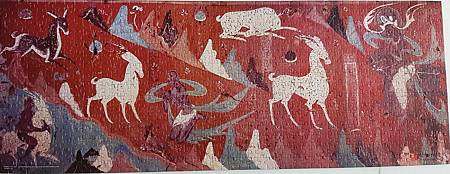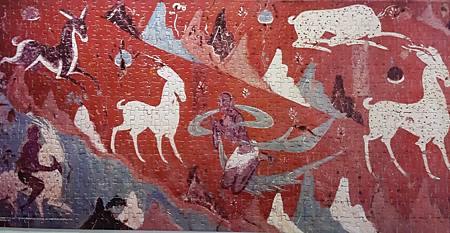



TOi,2021.06,No.12624
Original from Dunhuang
size: 70x26 cm
Made in China
TOi與敦煌研究院合作出品(Dunhuang Academy)
敦煌研究院總算找到品質優良的拼圖商了!!
這系列的最後一發~~~
https://www.e-dunhuang.com/cave/10.0001/0001.0001.0257
莫高窟 第257窟 九色鹿本生 主室 西壁
时代:北魏(公元368年-534年)
该窟建于北魏统一河西后。原为人字披中心塔柱窟,因东壁塌毁,仅存人字披少部及塔柱。整窟平面呈方形,窟顶前部为汉式人字披顶,西披画供养天人持莲花,脊枋存部分平棋图案;后部为平棋顶,仅东南角存斗四平棋图案两方,其中一方中央表现莲池中裸体童子游泳,外侧四角表现四身飞天,边沿以忍冬装饰。 后部中央有中心塔柱连接窟顶与地面,塔柱四面开龛,东向面开圆券形主龛,龛内塑倚坐弥勒说法像(眼、鼻、手已损毁),着右袒式袈裟,衣褶采用贴泥条和刻阴刻线相结合的表现手法,自然流畅。龛内两侧分上下层各绘十身供养菩萨,龛顶画四身飞天及佛背光图案,龛楣装饰莲花化生图案,两端为双龙装饰。主龛外原塑天王二身,现北侧存一身天王像,是莫高窟现存北朝唯一的彩塑天王像。龛上部存浮塑供养菩萨,龛下部塔座座沿北魏画供养人(模糊),塔座最下部有宋朝绘供养人像(模糊)。塔柱其余三面均上下开龛,南北面上层均作阙形龛,内塑菩萨像,西壁与其他各龛均塑禅定像,各龛外两侧均塑菩萨像。 此窟前半部南北壁东侧(人字披下)画大型说法图,现大部已毁;靠后各部中央画小型说法图一铺。后半部现存西、南、北三壁壁画,作三段式布局,上段画天宫伎乐通绕全窟,中段画千佛,最下层为药叉(金刚力士)。在千佛、力士之间,有一横长的故事画带通联三壁,南壁画沙弥守戒自杀因缘故事及弊狗因缘故事,西壁绘九色鹿王本生故事,西壁北段与北壁画须摩提女因缘故事。这些在赭红底壁上绘成的故事画,都以人物、动物为主,山水、房宇、车马、器物仅为衬景,这正是汉晋传统画风在佛教壁画上的延续。 此窟的连环故事画,是莫高窟开窟以来的全新构图形式,是敦煌壁画故事中的经典之作,对此后莫高窟佛教艺术的发展具有深远的影响。
This cave was constructed in the period when the Hexi region was united by the Northern Wei. Originally it was a cave with a central pillar, a gabled ceiling in the front and a flat ceiling in the back. Due to the collapse of the east wall, only a tiny part of the gable ceiling is preserved today. The cave is square in plan with a Han Chinese styled gabled ceiling in the front. On the west slope are celestial beings holding lotuses. The beam is decorated with painted laternendecke motifs. On the flat ceiling are also painted laternendecke motifs, though only two motifs in the southeast corner have survived. One of them depicts a few naked children swimming in a lotus pond. In the outer corner are four asparas. It was surrounded by a decorative border of honeysuckles.The central pillar in the back connects the ground with the ceiling. It has a niche on each of its four sides. The arch niche in the east side contains a statue of Maitreya sitting with legs pendent (whose eyes, nose and hands have been damaged) and wearing a kasaya with the right shoulder exposed. The folds were made by sticking on strips of mud and inscribing natural and smooth lines. The exterior of the niche is divided into an upper level and a lower level, which are respectively covered with ten attendant bodhisattvas. On the top of the niche are four apsaras and Buddha\'s halos. The niche lintel is decorated with reborn children on lotuses and a dragon head on each end. There was a heavenly king alongside each side of the niche. Now there is only one left. This is the only painted statue of lokapala of the Northern Dynasties at Mogao. Above the niche are molded statues stuck to the surface, and below, along the edge of the niche are donors of the Northern Wei (obscured). At the bottom of the base are donors of the Song dynasty (obscured). There other three sides each have a upper niche and a lower niche. The two upper niches on the south and north sides are shaped like the Han Chinese city gates with a bodhisattva statue inside, while the other niches contain a dhyana Buddha statue flanked by two bodhisattva statues out of the niches.On the north and south walls below the gabled ceiling are large-sized preaching scenes, most of which are damaged. In the center of the back part of the sidewalls is a small preaching scene. The extant murals on the west, south and north walls in the back of the chamber are divided into three registers from top down respectively for the heavenly musicians, thousand Buddha motifs, and yakshas. Between the images of the yakshas and the thousand Buddha motifs is a horizontal band of narrative stories which runs through the three walls. On the south wall is the narrative about a Samanera (novice monk) committing suicide in order to obey Buddhist precepts and about the karma stories of an inferior dog. On the west wall is the nine-colored deer jataka, and on the north part of the west wall and the north wall are paintings about the karma of Lady Sumati. These story murals painted on a redish brown ground, focus on the figures and animals, while the landscape, houses, horses and chariots are just used to suggest the background of the story. This is exactly the extension of the traditional Han and Jin painting styles in Buddhist murals.The narrative story paintings in this cave are rendered in a comptetely new style and composition compared to the earlier works form the inception of the Mogao Grottoes. They are the masterpieces of the narrative story paintings at Mogao, which exerted far-reaching influence on the development of the Buddhist art at Mogao.
上画天宫伎乐十六身,中画千佛,中央趺坐佛说法图一铺,下南起画九色鹿王本生一铺、须摩提女因缘(前半部)。图下画边饰一条,下药叉一排(模糊)。 九色鹿本生故事画为横卷式连环画,绘八个情节,由左右两端开始,中间结束。画面为:1、溺人落水。2、九色鹿救起溺人调达。3、调达跪地谢恩。4、王后要国王捉鹿。5、调达告密。6、国王率军捉鹿。7、乌鸦叫醒九色鹿。8、九色鹿向国王控诉调达。本生故事是表现释迦牟尼佛在过去世中为菩萨时教化众生,普行六度的种种事迹。此铺故事画依据《佛说九色鹿经》绘制,生动表现了人物的神情和内心活动,突出了这一故事宣扬的因果报应的佛教主旨,对画中马的刻画采用写实与夸张相结合的手法,富于弹力。 西壁北段(和北壁)根据三国时期支谦译《须摩提女经》绘须摩提女故事画,共描绘十四个情节(此壁绘前半部情节1-3):1、须摩提女闭门卧床和焚香请佛。2、乾荼背锅飞来。3、均头沙弥乘五百花树飞来。
On the upper part are images of sixteen heavenly musicians, below them are the thousand Buddhas in the center of which is a preaching scene, and at the lowest part are narrative story paintings of the Nine-colored Deer Jataka, which consists of eight episodes. The story begins from two ends and ends in the middle. The episodes are: 1. a man fell into the river; 2. a nine-colored deer saved the drown man, devadatta; 3.devadatta knelt down to thank the deer; 4. the queen of the kingdom wanted to capture the deer; 5. devadatta told the king where the deer lived; 6. the king led his army to hunt for the deer; 7. A crow awoke the deer; 8. the deer told the king about devadatta. The jataka tales are stories about Sakyamuni as a bodhisattva in his previous life trying to enlighten the human beings and spread six perfections. It was painted according to the the Sutra on the Nine-colored Deer, and the airs and inner emotion of each figure are vividly rendered, highlighting the Buddhist main idea on karmic retribution.The horse in the painting was depicted in both realistic and exaggerated styles, looking dynamic. The north section on the west wall (and together with the part on the north wall) is the karma story of Lady Sumati according to the Sutra on Lady Sumati translated by Lokaksema in the Three Kingdoms Period, which consists of 14 scenes, and the first three episodes are on the west wall: 1.Lady Sumati lying in bed and inviting Buddha by burning incenses; 2.One of Buddha\'s disciple coming with a span on back; 3. A novice monk coming by riding five hundred flower trees.








 留言列表
留言列表
 A.K.A.
A.K.A. 